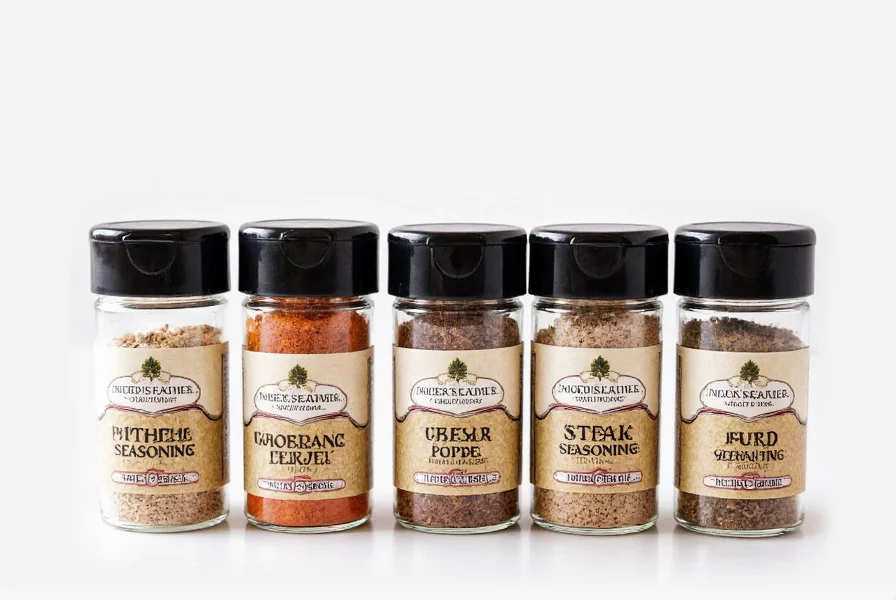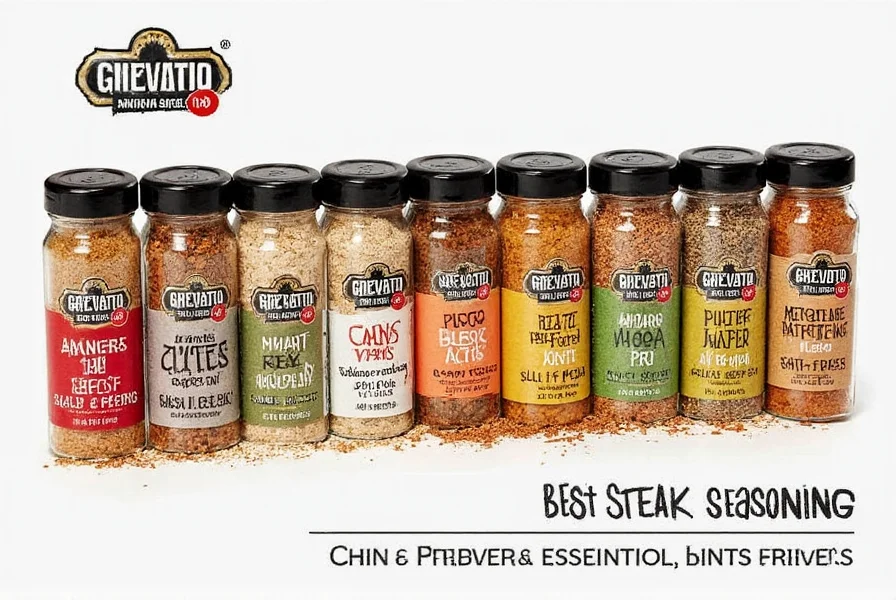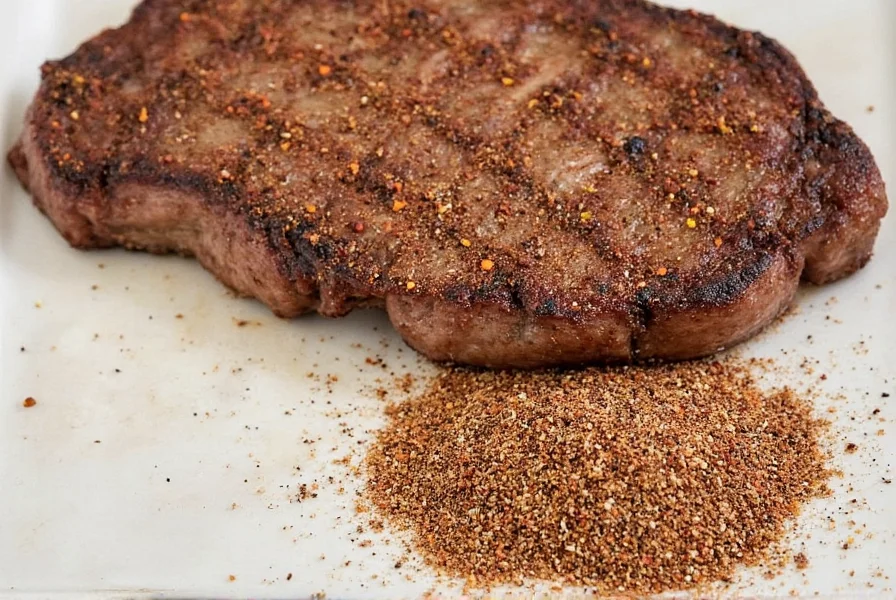The most essential steak seasonings are coarse salt (like kosher salt) and freshly ground black pepper. For a classic preparation, use 3/4 teaspoon of coarse salt and 1/4 teaspoon of freshly ground black pepper per pound of steak, applied at least 40 minutes before cooking. This simple combination enhances the natural beef flavor without overpowering it. Additional seasonings like garlic powder, onion powder, smoked paprika, or dried herbs can complement specific cuts or cooking methods.
Seasoning steak properly transforms a good cut of beef into an exceptional meal. While many elaborate spice blends exist, understanding the fundamentals of steak seasoning ensures consistently delicious results whether you're grilling, pan-searing, or broiling. The right seasoning approach depends on the cut of steak, cooking method, and personal taste preferences.
The Science Behind Steak Seasoning
When seasoning steak, you're not just adding flavor—you're participating in chemical reactions that affect texture and taste. Salt plays a dual role: it enhances flavor perception and, through osmosis, helps tenderize the meat's surface. The timing of salting significantly impacts results. Applying salt 40-60 minutes before cooking allows it to dissolve, penetrate slightly, and reabsorb into the meat, seasoning from within rather than just coating the surface.
Pepper provides aromatic complexity but burns at high temperatures. Adding it before searing creates a flavorful crust with subtle bitterness, while adding it after preserves its brighter notes. Understanding these principles helps you make informed decisions about when to season steak before cooking for optimal results.
Essential Steak Seasoning Components
Every effective steak seasoning strategy incorporates these fundamental elements:
| Component | Function | Recommended Amount |
|---|---|---|
| Coarse Salt | Flavor enhancer, tenderizer | 3/4 tsp per pound |
| Freshly Ground Pepper | Aromatic complexity | 1/4 tsp per pound |
| Garlic Powder | Umami depth | 1/8 tsp per pound |
| Onion Powder | Sweetness foundation | 1/8 tsp per pound |
Steak-Specific Seasoning Recommendations
Different cuts benefit from tailored seasoning approaches. Understanding best steak seasoning for ribeye versus leaner cuts ensures optimal flavor pairing:
- Ribeye/Fatty Cuts: Balance richness with assertive seasonings. Try 3/4 tsp coarse salt, 1/4 tsp black pepper, 1/8 tsp garlic powder, and a pinch of cayenne. The marbling carries bold flavors beautifully.
- Filet Mignon/Lean Cuts: Use more delicate seasoning to avoid overwhelming subtle flavors. 3/4 tsp salt, 1/4 tsp pepper, and 1/8 tsp dried thyme preserves the steak's elegance.
- Flank/Skirt Steaks: These benefit from acidic components. Combine 3/4 tsp salt, 1/4 tsp pepper, 1/2 tsp cumin, and 1 tsp citrus zest for steak seasoning blends for grill that tenderizes and flavors.

Timing Your Seasoning for Maximum Impact
The question of when to season steak before cooking significantly affects results:
- 45-60 Minutes Before Cooking: Ideal for salt application. Allows salt to dissolve and partially penetrate, seasoning the interior while drawing moisture to the surface for better searing.
- Immediately Before Cooking: Best for pepper and delicate herbs that burn easily. Prevents charring while still imparting flavor.
- After Cooking: Reserve for finishing salts (like flaky sea salt) or delicate herbs that lose potency with heat. Enhances final presentation and flavor complexity.
Creating Your Own Steak Seasoning Blends
Mastering homemade steak seasoning recipe development lets you customize to your taste. Start with this versatile base:
- 1/4 cup coarse salt
- 2 tablespoons freshly ground black pepper
- 1 tablespoon garlic powder
- 1 tablespoon onion powder
- 1 teaspoon smoked paprika
- 1 teaspoon dried thyme
Mix thoroughly and store in an airtight container. This blend works exceptionally well as a classic steak seasoning recipe for most cuts. For variation, add 1/2 teaspoon of cayenne for heat, or substitute dried rosemary for thyme for a more robust profile.
Avoiding Common Steak Seasoning Mistakes
Even experienced cooks make these seasoning errors:
- Using fine table salt: It dissolves too quickly and penetrates too deeply, creating uneven seasoning. Always use coarse salt for steak.
- Seasoning too close to cooking time: Less than 30 minutes before cooking prevents proper salt absorption, leaving seasoning only on the surface.
- Adding wet ingredients too early: Marinades with acid or moisture create a barrier that prevents proper browning. Save wet components for after cooking.
- Overcomplicating the blend: More than 5-6 seasoning components typically creates flavor confusion rather than harmony.
International Steak Seasoning Traditions
Exploring global approaches to what spices go well with steak expands your culinary repertoire:
- Argentinian Chimichurri Rub: Blend 2 tablespoons dried parsley, 1 tablespoon oregano, 2 teaspoons red pepper flakes, and 1 teaspoon garlic powder. Apply before grilling, then serve with fresh chimichurri sauce.
- Japanese Shio Koji: A fermented rice-based seasoning that tenderizes while adding umami. Mix equal parts shio koji, salt, and pepper for an hour-long marinade.
- French Herbes de Provence: Combine 2 tablespoons herbes de Provence, 1 tablespoon sea salt, and 1 teaspoon black pepper for a floral, earthy profile perfect for filet mignon.

Final Seasoning Considerations
Remember that high-quality beef needs minimal seasoning to shine. The marbling and natural flavor of well-raised cattle form the foundation of great steak. When selecting seasonings, consider your cooking method—grilled steaks handle bolder flavors than pan-seared, while broiled steaks benefit from seasonings that won't burn under intense direct heat.
For those exploring best steak seasoning for ribeye specifically, remember that this well-marbled cut can handle more assertive seasonings than leaner cuts. A simple salt and pepper preparation often proves most satisfying, allowing the rich beef flavor to take center stage.
How much salt should I use when seasoning steak?
Use approximately 3/4 teaspoon of coarse salt per pound of steak. This ratio provides proper seasoning without overwhelming the meat. For thicker cuts, you may need slightly more as salt penetrates only about 1/4 inch into the surface.
Should I season both sides of the steak?
Yes, season both sides evenly. Steak cooks from both sides during the searing process, so seasoning only one side creates uneven flavor distribution. Apply seasoning to all surfaces, including the edges of thicker cuts.
Can I use a steak seasoning blend immediately before cooking?
You can apply dry seasoning blends right before cooking, but for optimal results, salt should be applied 40-60 minutes beforehand. Pepper and delicate herbs are best added just before cooking to prevent burning, while salt benefits from early application to penetrate the meat surface.
What's the difference between using fresh versus dried herbs for steak seasoning?
Dried herbs work better in dry rubs as they're more concentrated and withstand high heat. Fresh herbs typically burn when applied directly before searing. If using fresh herbs, incorporate them into a finishing compound butter or sauce rather than as part of the initial seasoning.
Do I need to oil the steak before seasoning?
No, oiling before seasoning causes the spices to slide off. Instead, apply seasoning directly to the dry steak surface, then lightly oil the cooking surface or the steak just before it hits the pan or grill. This ensures proper adhesion of the seasoning and promotes better browning.
Frequently Asked Questions
- How much salt should I use when seasoning steak?
- Use approximately 3/4 teaspoon of coarse salt per pound of steak. This ratio provides proper seasoning without overwhelming the meat. For thicker cuts, you may need slightly more as salt penetrates only about 1/4 inch into the surface.
- Should I season both sides of the steak?
- Yes, season both sides evenly. Steak cooks from both sides during the searing process, so seasoning only one side creates uneven flavor distribution. Apply seasoning to all surfaces, including the edges of thicker cuts.
- Can I use a steak seasoning blend immediately before cooking?
- You can apply dry seasoning blends right before cooking, but for optimal results, salt should be applied 40-60 minutes beforehand. Pepper and delicate herbs are best added just before cooking to prevent burning, while salt benefits from early application to penetrate the meat surface.
- What's the difference between using fresh versus dried herbs for steak seasoning?
- Dried herbs work better in dry rubs as they're more concentrated and withstand high heat. Fresh herbs typically burn when applied directly before searing. If using fresh herbs, incorporate them into a finishing compound butter or sauce rather than as part of the initial seasoning.
- Do I need to oil the steak before seasoning?
- No, oiling before seasoning causes the spices to slide off. Instead, apply seasoning directly to the dry steak surface, then lightly oil the cooking surface or the steak just before it hits the pan or grill. This ensures proper adhesion of the seasoning and promotes better browning.











 浙公网安备
33010002000092号
浙公网安备
33010002000092号 浙B2-20120091-4
浙B2-20120091-4